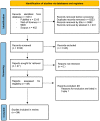Open Questions in Cold Atmospheric Plasma Treatment in Head and Neck Cancer: A Systematic Review
- PMID: 36142145
- PMCID: PMC9498988
- DOI: 10.3390/ijms231810238
Open Questions in Cold Atmospheric Plasma Treatment in Head and Neck Cancer: A Systematic Review
Abstract
Over the past decade, we witnessed a promising application of cold atmospheric plasma (CAP) in cancer therapy. The aim of this systematic review was to provide an exhaustive state of the art of CAP employed for the treatment of head and neck cancer (HNC), a tumor whose late diagnosis, local recurrence, distant metastases, and treatment failure are the main causes of patients' death. Specifically, the characteristics and settings of the CAP devices and the in vitro and in vivo treatment protocols were summarized to meet the urgent need for standardization. Its molecular mechanisms of action, as well as the successes and pitfalls of current CAP applications in HNC, were discussed. Finally, the interesting emerging preclinical hypotheses that warrant further clinical investigation have risen. A total of 24 studies were included. Most studies used a plasma jet device (54.2%). Argon resulted as the mostly employed working gas (33.32%). Direct and indirect plasma application was reported in 87.5% and 20.8% of studies, respectively. In vitro investigations were 79.17%, most of them concerned with direct treatment (78.94%). Only eight (33.32%) in vivo studies were found; three were conducted in mice, and five on human beings. CAP showed pro-apoptotic effects more efficiently in tumor cells than in normal cells by altering redox balance in a way that oxidative distress leads to cell death. In preclinical studies, it exhibited efficacy and tolerability. Results from this systematic review pointed out the current limitations of translational application of CAP in the urge of standardization of the current protocols while highlighting promising effects as supporting treatment in HNC.
Keywords: RONS; apoptosis; cold atmospheric plasma; head and neck cancer.
Conflict of interest statement
The authors declare no conflict of interest.
Figures






Similar articles
-
Home treatment for mental health problems: a systematic review.Health Technol Assess. 2001;5(15):1-139. doi: 10.3310/hta5150. Health Technol Assess. 2001. PMID: 11532236
-
A rapid and systematic review of the clinical effectiveness and cost-effectiveness of paclitaxel, docetaxel, gemcitabine and vinorelbine in non-small-cell lung cancer.Health Technol Assess. 2001;5(32):1-195. doi: 10.3310/hta5320. Health Technol Assess. 2001. PMID: 12065068
-
Cost-effectiveness of using prognostic information to select women with breast cancer for adjuvant systemic therapy.Health Technol Assess. 2006 Sep;10(34):iii-iv, ix-xi, 1-204. doi: 10.3310/hta10340. Health Technol Assess. 2006. PMID: 16959170
-
Signs and symptoms to determine if a patient presenting in primary care or hospital outpatient settings has COVID-19.Cochrane Database Syst Rev. 2022 May 20;5(5):CD013665. doi: 10.1002/14651858.CD013665.pub3. Cochrane Database Syst Rev. 2022. PMID: 35593186 Free PMC article.
-
Topotecan, pegylated liposomal doxorubicin hydrochloride and paclitaxel for second-line or subsequent treatment of advanced ovarian cancer: a systematic review and economic evaluation.Health Technol Assess. 2006 Mar;10(9):1-132. iii-iv. doi: 10.3310/hta10090. Health Technol Assess. 2006. PMID: 16545208
Cited by
-
Plasma Bioscience and Medicine Molecular Research.Int J Mol Sci. 2023 May 24;24(11):9174. doi: 10.3390/ijms24119174. Int J Mol Sci. 2023. PMID: 37298125 Free PMC article.
-
Pharmacological impact of microRNAs in head and neck squamous cell carcinoma: Prevailing insights on molecular pathways, diagnosis, and nanomedicine treatment.Front Pharmacol. 2023 May 3;14:1174330. doi: 10.3389/fphar.2023.1174330. eCollection 2023. Front Pharmacol. 2023. PMID: 37205904 Free PMC article. Review.
-
Antitumor Potential of Different Treatment Approaches Using Cold Atmospheric Pressure Plasma on Oral Squamous Cell Carcinoma Models: In Vitro Study.Biomedicines. 2025 Feb 11;13(2):443. doi: 10.3390/biomedicines13020443. Biomedicines. 2025. PMID: 40002856 Free PMC article.
-
Adjunctive Treatment Effect of Non-Thermal Atmospheric Pressure Plasma in Periodontitis-Induced Rats.J Clin Med. 2025 Jan 29;14(3):896. doi: 10.3390/jcm14030896. J Clin Med. 2025. PMID: 39941567 Free PMC article.
-
Cold atmospheric plasma enhances SLC7A11-mediated ferroptosis in non-small cell lung cancer by regulating PCAF mediated HOXB9 acetylation.Redox Biol. 2024 Sep;75:103299. doi: 10.1016/j.redox.2024.103299. Epub 2024 Aug 3. Redox Biol. 2024. PMID: 39127016 Free PMC article.
References
-
- Svahn M.F., Munk C., Nielsen T.S.S., von Buchwald C., Frederiksen K., Kjaer S.K. Trends in all-cause five-year mortality after head and neck cancers diagnosed over a period of 33 years. Focus on estimated degree of association with human papillomavirus. Acta Oncol. 2016;55:1084–1090. doi: 10.1080/0284186X.2016.1185148. - DOI - PubMed
-
- National Cancer Institute Cancer Stat Facts: Oral Cavity and Pharynx Cancer. [(accessed on 24 June 2022)]; Available online: https://seer.cancer.gov/statfacts/html/oralcav.html.
-
- Guerrero-Preston R., Ogawa T., Uemura M., Shumulinsky G., Valle B.L., Pirini F., Ravi R., Sidransky D., Keidar M., Trink B. Cold atmospheric plasma treatment selectively targets head and neck squamous cell carcinoma cells. Int. J. Mol. Med. 2014;34:941–946. doi: 10.3892/ijmm.2014.1849. - DOI - PMC - PubMed
Publication types
MeSH terms
Substances
LinkOut - more resources
Full Text Sources
Medical
Miscellaneous

